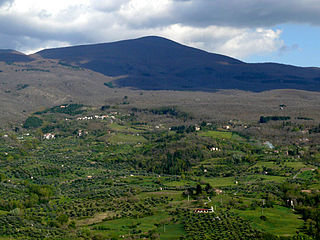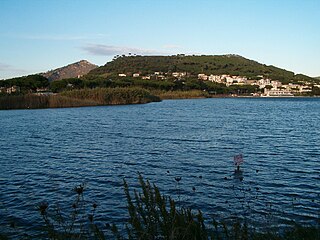 W
WThe Aeolian Islands, sometimes referred to as the Lipari Islands or Lipari group after their largest island, are a volcanic archipelago in the Tyrrhenian Sea north of Sicily, named after the demigod of the winds Aeolus. The islands' inhabitants are known as Aeolians. The islands had a permanent population of 14,224 at the 2011 census; the latest official estimate is 15,419 as of 1 January 2019. The Aeolian Islands are a popular tourist destination in the summer and attract up to 600,000 visitors annually.
 W
WAgnano is a suburb of Napoli, Italy, situated southwest of the city in the Campi Flegrei region. It was popular among both ancient Greeks and Romans and was famed for its hot sulphurous springs.
 W
WThe Alban Hills are the caldera remains of a quiescent volcanic complex in Italy, located 20 km (12 mi) southeast of Rome and about 24 km (15 mi) north of Anzio. The 950 m (3,120 ft) high Monte Cavo forms a highly visible peak the centre of the caldera, but the highest point is Maschio delle Faete approximately 2 km (1.2 mi) to the east of Cavo and 6 m (20 ft) taller. There are subsidiary calderas along the rim of the Alban Hills that contain the lakes Albano and Nemi. The hills are composed of peperino, a variety of tuff that is useful for construction and provides a mineral-rich substrate for nearby vineyards.
 W
WMount Amiata is the largest of the lava domes in the Amiata lava dome complex located about 20 km northwest of Lake Bolsena in the southern Tuscany region of Italy. It is located within the provinces of Grosseto and Siena.
 W
WAvernus was an ancient name for a volcanic crater near Cumae (Cuma), Italy, in the region of Campania west of Naples. Part of the Phlegraean Fields of volcanoes, Avernus is approximately 3.2 kilometres (2.0 mi) in circumference. Within the crater is Lake Avernus.
 W
WLake Avernus is a volcanic crater lake located in the Avernus crater in the Campania region of southern Italy, around 4 km (2.5 mi) west of Pozzuoli. It is near the volcanic field known as the Phlegraean Fields and comprises part of the wider Campanian volcanic arc. The lake is roughly circular, measuring 2 km (1.2 mi) in circumference and 60 m (213 ft) deep.
 W
WMount Barbaro or Mount Gauro in Italy Monte Barbaro or Monte Gauro, is one of the eruptive vents of the Phlegraean Fields, a volcanic field of Italy located in Campania.
 W
WThe Campanian volcanic arc is a volcanic arc that consists of a number of active, dormant, and extinct volcanoes in the Campania region of Italy. The Campanian volcanic arc centers on the bay of Naples and includes:Mount Vesuvius: an active volcano that last erupted in 1944. Phlegraean Fields: a huge, ancient caldera containing the western area of Naples. The area is a collection of numerous extinct craters that are evidence of ancient eruptions; however, also included in this area is Solfatara, a shallow volcanic crater still emitting jets of sulfur fumes and, thus, still active. Mount Epomeo: 20 kilometres west of Naples on the island of Ischia, it last erupted in 1302. Palinuro, Vavilev, Marsili, and Magnaghi: undersea extinct or dormant volcanoes south of Vesuvius. The last three were discovered in the 1950s and bear the names of the geologists who discovered them. Palinuro was known earlier. As of 2006, there was some concern about the state of "dormancy" of Marsili, which is 3,000 meters high with the cone reaching to 500 meters from the surface of the water. Satellite cones of recent origin have been detected on Marsili.
 W
WCapraia is an Italian island, the northwesternmost of the seven islands of the Tuscan Archipelago, and the third largest after Elba and Giglio.
 W
WThe Cyclopean Isles, noted for their rows of basaltic columns piled one above another, lie not far from Mount Etna off the eastern coast of Sicily in the Mediterranean Sea.
 W
WEmpedocles is a large underwater volcano located 40 km off the southern coast of Sicily named after the Greek philosopher Empedocles who believed that everything on Earth was made up of the four elements.
 W
WThe Euganean Hills are a group of hills of volcanic origin that rise to heights of 300 to 600 m from the Padovan-Venetian plain a few km south of Padua. The Colli Euganei form the first Regional park established in the Veneto (1989), enclosing fifteen towns and eighty one hills.
 W
WGraham Island was an island created by a now fully submerged volcano in the Mediterranean Sea. It was discovered when it last appeared on 1 August 1831 by Humphrey Fleming Senhouse, the captain of the first rate Royal Navy ship of the line St Vincent and named after Sir James Graham, the First Lord of the Admiralty. It was claimed by the United Kingdom. It forms part of the underwater volcano Empedocles, 30 km (19 mi) south of Sicily, and which is one of a number of submarine volcanoes known as the Campi Flegrei del Mar di Sicilia. Seamount eruptions have raised it above sea level several times before erosion submerged it again.
 W
WLarderello is a frazione of the comune of Pomarance, in Tuscany in central Italy, renowned for its geothermal productivity.
 W
WLinosa is one of the Pelagie Islands in the Sicily Channel of the Mediterranean Sea.
 W
WMarsili is a large undersea volcano in the Tyrrhenian Sea, about 175 kilometers (109 mi) south of Naples. The seamount is about 3,000 m tall; its peak and crater are about 450 m below the sea surface. Though it has not erupted in recorded history, volcanologists believe that Marsili is a relatively fragile-walled structure, made of low-density and unstable rocks, fed by the underlying shallow magma chamber. Volcanologists with the Italian National Institute of Geophysics and Volcanology (INGV) announced on March 29, 2010 that Marsili could erupt at any time, and might experience a catastrophic collapse that would suddenly release vast amounts of magma in an undersea eruption and landslide that could trigger destructive tsunamis on the Italian coast and nearby Mediterranean coastlines.
 W
WMount Lauro is a mountain reaching 986 metres located in south-eastern Sicily belonging to the chain of Hyblaean Mountains, stretching between the three provinces of Catania, Ragusa and Siracusa. Monte Lauro is part of a complex of extinct volcanoes having formed under the sea during the Miocene epoch.
 W
WThe Monti Sabatini is a geologic region in Lazio, central Italy, a remnant of intense volcanism which started ca. 600,000 years ago, mainly with pyroclastic and maar forming eruptions which continued until 100,000 years ago. The mountains are part of the Lazio's Anti-Apennines. Included between the Monti Sabatini is the Lake Bracciano, which is a volcanotectonic depression formed about 3.7 Ma, and the Lake Martignano. The sedimentary base of the Sabatini complex lies buried under 200 m (660 ft) of volcanic ash and rocks.
 W
WMontiferru is a historical region of central-western Sardinia, Italy. It takes its name from the eponymous extinct volcano massif, whose main peak is the Monte Urtigu (1,050 m). Extending for some 700 km², the massif had originally a maximum elevation of c. 1,600/1,700 m, later reduced due to erosion.
 W
WNisida is a volcanic islet of the Flegrean Islands archipelago, in southern Italy. It lies at a very short distance from Cape Posillipo, just north of Naples; it is now connected to the mainland by a stone bridge. The islet is almost circular, with a flooded crater forming the bay of Porto Paone on the southwest coast. It has a diameter of about 0.5 kilometres and a highest altitude of 105 metres.
 W
WMonte Nuovo is a cinder cone volcano within the Campi Flegrei caldera, near Naples, southern Italy. A series of damaging earthquakes and changes in land elevation preceded its only eruption, during the most recent part of the Holocene, which lasted from September 29 to October 6, 1538, when it was formed. The event is important in the history of science because it was the first eruption in modern times to be described by a large number of witnesses. The eruptive vent formed next to the medieval village of Tripergole on the shores of the then-much larger Lake Lucrino. The thermal bath village, which had been inhabited since ancient Roman times and was home to notable Roman-era buildings including Cicero's villa, was completely buried by ejecta from the new cinder cone. Tripergole's ruins and its important thermal springs completely disappeared under Monte Nuovo such that the exact location of the village can no longer be identified.
 W
WOrvieto is a city and comune in the Province of Terni, southwestern Umbria, Italy situated on the flat summit of a large butte of volcanic tuff. The city rises dramatically above the almost-vertical faces of tuff cliffs that are completed by defensive walls built of the same stone, called tufa.
 W
WPantelleria, the ancient Cossyra or Cossura, is an Italian island and comune in the Strait of Sicily in the Mediterranean Sea, 100 km (62 mi) southwest of Sicily and 60 km (37 mi) east of the Tunisian coast. On clear days Tunisia is visible from the island. Administratively Pantelleria's comune belongs to the Sicilian province of Trapani.
 W
WThe Volcano of Roccamonfina is an extinct volcano in Roccamonfina, Campania, southern Italy. It was active from some 650,000 to 50,000 years ago. It comprises an isolated large cone of some 25 km (16 mi) perimeter between the Monti Aurunci, the plain and valley of the Garigliano, the Monte Massico and the Monti Trebulani. The central caldera has a diameter of nearly 6 km (4 mi) and the small commune (town) of Roccamonfina is located inside it. Volcanic activity is now replaced by minor seismic movements and by the presence of mineral waters. The mount is part of the Roccamonfina-Garigliano Mouth Regional Park, created in 1999.
 W
WSalina is one of the Aeolian Islands north of Sicily, southern Italy. It is the second largest island in the archipelago.
 W
WSciara del Fuoco is a talus scree or depression located on Stromboli Island in Italy. It runs along the island's northern flank and is bounded by two ridges. It now serves as a major tourist attraction on the island.
 W
WSolfatara is a shallow volcanic crater at Pozzuoli, near Naples, part of the Phlegraean Fields volcanic area. It is a dormant volcano, which still emits jets of steam with sulfurous fumes. The name comes from the Latin, Sulpha terra, "land of sulfur", or "sulfur earth". It was formed around 4000 years ago and last erupted in 1198 with what was probably a phreatic eruption – an explosive steam-driven eruption caused when groundwater interacts with magma. The crater floor is a popular tourist attraction, as it has many fumaroles and mud pools. The area is well known for its bradyseism. The vapours have been used for medical purposes since Roman times.
 W
WStrombolicchio is a sea stack of volcanic origin 2 km (1.2 mi) to the northeast of the island of Stromboli in the Aeolian Islands of Italy. Its name in the Sicilian language means Little Stromboli.
 W
WVivara is a satellite islet of Procida, one of the three main islands in the Gulf of Naples.
 W
WMount Vulture is an extinct volcano located 56 km (35 mi) north of the city Potenza in the Basilicata region (Italy). As a prominent landmark it gave its name to the Vulture region, the most significant viticultural zone in Basilicata growing the DOC wine Aglianico del Vulture.